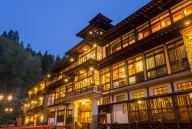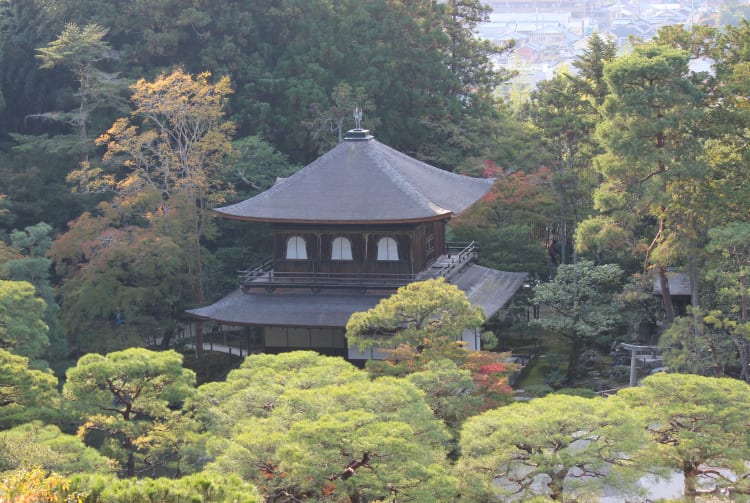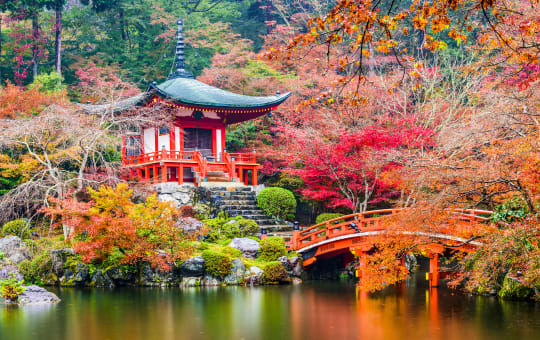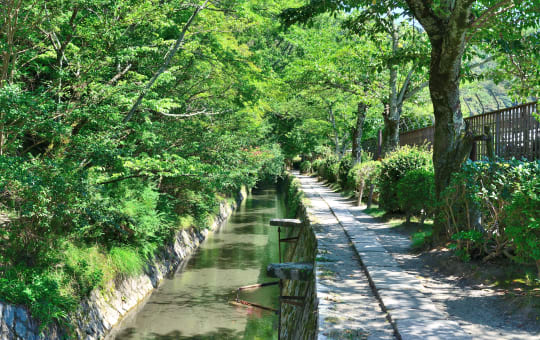Ein klassischer Zen-Tempel im ehemaligen Altersruhesitz eines Shoguns
Der Ginkakuji, der einst im 15. Jahrhundert als Altersruhesitz eines Shoguns erbaut wurde, ist einer der klassischsten Zen-Tempel Japans und ein Paradebeispiel der Wabi-sabi-Ästhetik, die Schönheit im Unvollkommenen findet. Bevor die Villa des Shoguns zu einem Tempel wurde, war sie das Zentrum der Higashiyama-Kultur, aus der die Teezeremonie, das Blumenarrangement, die Poesie und das No-Theater erblühten. Heutzutage ist der Ginkakuji einer der bekanntesten Tempel in Kyoto.
Trotz seines Namens („Silberpavillon“) fehlt dem Ginkakuji etwas, und zwar Silber. Der Shogun Ashikaga Yoshimasa plante ursprünglich, die Gebäudeaußenseite mit Silber zu verkleiden, wozu es jedoch nie kam.
Nicht verpassen
- Ginkaku, das Haupttempelgebäude
- Ruhe und Frieden im makellosen Zen-Garten
- Weitere architektonische Schätze wie Teehäuser
Anfahrt
Der Ginkakuji-Tempel liegt im nördlichen Higashiyama-Bezirk der Stadt Kyoto. Er befindet sich im Herzen des alten Kyotos neben dem Gelände des alten Kaiserlichen Palasts von Kyoto .
Nehmen Sie vom Bahnhof Kyoto den Bus Nr. 5 oder Nr. 17 zur Bushaltestelle Ginkakuji-michi. Von dort sind es noch 10 Minuten zu Fuß.
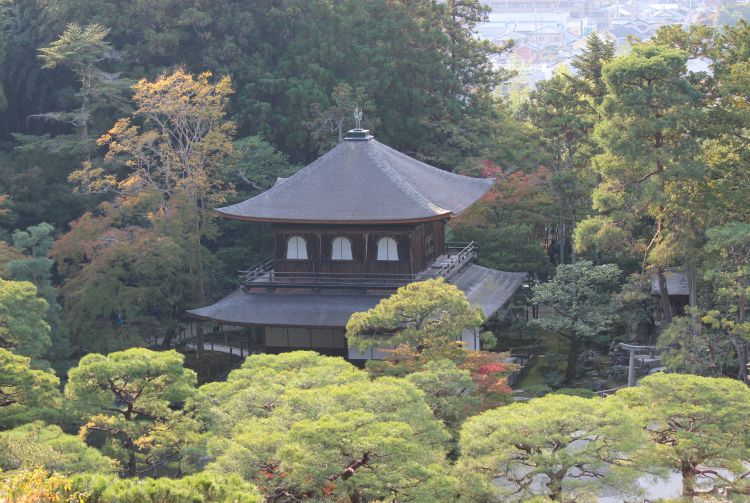
Eine Huldigung an Kinkakuji
Dieses Anwesen wurde ursprünglich im Jahr 1460 vom Shogun Ashikaga Yoshimasa im östlichen Kyoto als Altersruhesitz erbaut. Er fügte das Gebäude, das nun als Silberpavillon bekannt ist, im Jahr 1482 als Halle hinzu, die der Bodhisattva Kannon geweiht ist. Er entwarf das Gebäude so, dass es wie eine kleinere, bescheidenere Ausführung des Goldenen Pavillons (Kinkakuji) aussah, den sein Großvater, Ashikaga Yoshimitsu, in Auftrag gegeben hatte.
Wunderschön unvollkommen
Anstelle von Gold sollte der Ginkaku mit Silber überzogen werden. Dazu kam es jedoch nie. Der Bau mit seinem unvollendeten Äußeren soll nun genau so aussehen, wie Yoshimasa ihn zuletzt sah. Dies verkörpert perfekt die buddhistische Vorstellung von Wabi-sabi.
1485 wurde Yoshimasa Mönch und nahm den Namen Jisho („Strahlende Barmherzigkeit“) an, weshalb der offizielle Name des Tempels Jishoji lautet. Nach Yoshimasas Tod im Jahr 1490 wurde die Villa auf seinen Wunsch zu einem Tempel.
Einflussreiche Architektur
Der 1468 erbaute Togudo, vom Eingang aus links des Silberpavillons, ist das zweitwichtigste Gebäude der Anlage. Es handelt sich ebenfalls um eine buddhistische Halle, ist jedoch im Stil eines Wohnhauses gebaut. Der Togudo war ein radikales Stück Architektur und beeinflusste die elitäre Militärarchitektur noch über Generationen.
Darüber hinaus beeinflusste er den Stil moderner japanischer Häuser. Zu den bemerkenswerten und damals einzigartigen Besonderheiten gehören ein eingebauter Schreibtisch (Shoin), gestaffelte Regale, eine Tokonoma (Schaunische) und bemalte Schiebetrennwände. Alle diese Merkmale sind auch heute noch in traditionellen japanischen Häusern zu finden. Es heißt, dass dies das erste Beispiel eines 4,5 Tatami-Matten großen Teeraums ist, was zur elementaren Größe für die Teezeremonie wurde.
Sehnsucht nach Frieden
Yoshimasas Zeit als Shogun war durch Unruhen und Kämpfe geprägt, insbesondere durch den Onin-Krieg 1467–77. Yoshimasa war kein fähiger Herrscher. Er wollte sich lieber in Zurückgezogenheit entspannen. Als wichtiger Förderer der Künste lud er Maler und Poeten zu sich ein.
Kultur, die sich in der Nation ausbreitete
Der Ginkakuji war das Zentrum der Higashiyama-Kultur, die Adelige und Bürgerliche gleichermaßen beeinflusste. Viele der Künste, die weltweit als japanisch angesehen werden, entstanden in dieser Zeit, darunter die Teezeremonie, die Gartenanlage, die Poesie, das No-Theater, Ikebana (Blumenarrangement) und die japanische Architektur.
Die Anlage des Ginkakuji
Der Sandgarten des Ginkakuji ist berühmt für die säuberlich arrangierten Sandskulpturen, die den Berg Fuji darstellen sollen.
Dieser klassische japanische Tempel ist bei Besuchern einer der beliebtesten Orte in Kyoto. Besuchen Sie ihn daher am besten in der Nebensaison oder direkt nach der Öffnung oder kurz vor der Schließung. Auf einem Pfad hinter dem Garten können Sie den Besuchermassen entkommen. Dieser führt auf einen Hügel, der eine herrliche Aussicht auf den Tempel und die Stadt ringsherum bietet.
Ein Besuch des Ginkakuji kann in 1 Stunde absolviert werden. In der Umgebung finden sich jedoch noch viele weitere berühmte Stätten, unter anderem viele Tempel und Schreine wie den Chion-in-Tempel , den Nanzenji-Tempel und den Heian-Jingu-Schrein . In der Nähe befindet sich auch der Philosophenweg , ein Pfad, der sich an einem Bach entlang windet und dessen Bäume und Sträucher zur Kontemplation einladen.
Der Kyoto-Zoo, das städtische Kunstmuseum von Kyoto, das Nationalmuseum für moderne Kunst und andere der Kunst und Kultur von Kyoto und Japan gewidmete Einrichtungen machen diese Gegend ebenfalls lohnenswert für einen Besuch.
































